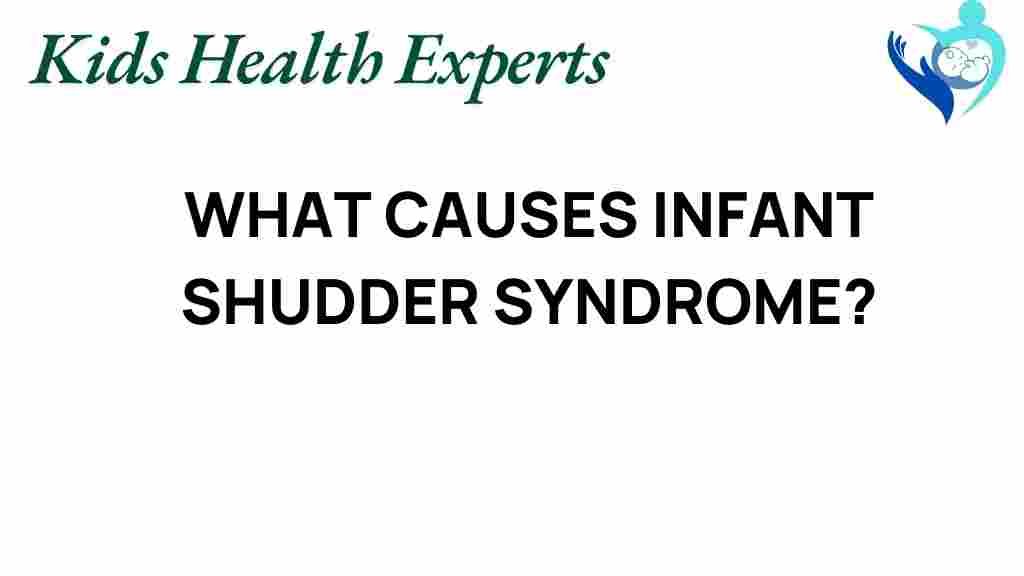Unraveling the Mysteries of Infant Shudder Syndrome
Infant Shudder Syndrome (ISS) is a term that often leaves parents puzzled and concerned when they witness their infants displaying sudden, involuntary movements. Understanding this condition is vital for pediatric health, as it can often be mistaken for more serious neurological issues. In this comprehensive article, we will delve into the causes, symptoms, diagnosis, and treatment of Infant Shudder Syndrome, providing parents with the knowledge they need to better support their little ones.
What is Infant Shudder Syndrome?
Infant Shudder Syndrome is characterized by brief episodes of shuddering or trembling in young infants, typically occurring between the ages of 3 months and 2 years. These episodes can be alarming to parents but are generally considered benign. Unlike seizures, which can signify serious neurological conditions, ISS does not usually lead to any long-term health issues.
Causes of Infant Shudder Syndrome
The exact cause of Infant Shudder Syndrome remains unclear, but several factors may contribute to its occurrence:
- Neurological Development: As the infant’s brain is rapidly developing, it may lead to temporary disruptions in motor control.
- Genetic Factors: There may be a hereditary component, as some families report a history of similar episodes.
- Environmental Triggers: Certain stimuli, such as loud noises or sudden movements, may trigger shuddering episodes.
Symptoms of Infant Shudder Syndrome
The primary symptom of Infant Shudder Syndrome is the shuddering itself. However, it is essential to recognize the characteristics of these episodes:
- Short duration, typically lasting only a few seconds.
- Involuntary body movements, often involving the shoulders, arms, or legs.
- No loss of consciousness or awareness during episodes.
- Episodes may occur in clusters or sporadically.
If you notice these symptoms, it is crucial to differentiate them from other conditions, such as seizures or tremors, which may require further medical evaluation.
Diagnosing Infant Shudder Syndrome
Diagnosing Infant Shudder Syndrome involves careful observation and consultation with a pediatrician. The following steps are typically taken:
- Medical History: The pediatrician will inquire about the infant’s health history and any family history of neurological conditions.
- Observation: Parents may be asked to describe the episodes in detail and, if possible, record a video of the shuddering.
- Neurological Examination: A thorough examination will help rule out other conditions, such as seizures or metabolic disorders.
- Additional Testing: In some cases, EEGs or MRIs may be recommended to assess brain activity and structure.
Treatment for Infant Shudder Syndrome
Fortunately, most infants outgrow Infant Shudder Syndrome without any intervention. However, if the episodes are frequent or concerning, the following treatments may be considered:
- Monitoring: Regular check-ups with a pediatrician to monitor the infant’s development.
- Parental Education: Educating parents about the condition can alleviate anxiety and help them manage episodes.
- Reassurance: Providing reassurance that ISS is typically benign and does not lead to serious health issues.
In rare cases, if there is suspicion of underlying neurological conditions, a pediatric neurologist may recommend further evaluations or treatments.
Pediatric Health and Infant Shudder Syndrome
Pediatric health encompasses a wide range of developmental milestones and conditions. Understanding Infant Shudder Syndrome is a crucial part of this landscape. Recognizing the early signs of ISS can help parents respond appropriately and seek medical advice when necessary.
Early Signs of Infant Shudder Syndrome
Identifying early signs of Infant Shudder Syndrome can be beneficial for parents. Here are some indicators to watch for:
- Shuddering or trembling movements that occur unexpectedly.
- Episodes that seem to happen more frequently during periods of excitement or stress.
- Any changes in behavior or development following the episodes.
If you observe these early signs, consider consulting with a healthcare provider to discuss your concerns.
Troubleshooting Tips for Concerned Parents
As a parent, witnessing your infant experience shuddering episodes can be distressing. Here are some troubleshooting tips to help you manage your concerns:
- Keep a Diary: Document the frequency, duration, and context of episodes to share with your pediatrician.
- Stay Calm: Maintaining a calm demeanor can help your infant feel secure during episodes.
- Educate Yourself: Learn as much as you can about Infant Shudder Syndrome to alleviate fears and misconceptions.
- Seek Support: Connect with other parents or support groups who have experienced similar situations.
Conclusion
Infant Shudder Syndrome is a condition that, while concerning, is generally benign and self-limiting. Understanding the causes, symptoms, diagnosis, and treatment options available can empower parents to support their infants during these episodes. Early recognition of symptoms and open communication with healthcare providers are key to ensuring pediatric health and well-being.
For further information on pediatric neurological conditions, you can explore resources such as Children’s Health. Remember, if you have any concerns about your child’s health, do not hesitate to consult with your pediatrician.
By unraveling the mysteries of Infant Shudder Syndrome, we can help demystify this condition and ease the worries of many parents navigating the early stages of their child’s development.
This article is in the category Conditions and created by KidsHealthExperts Team
